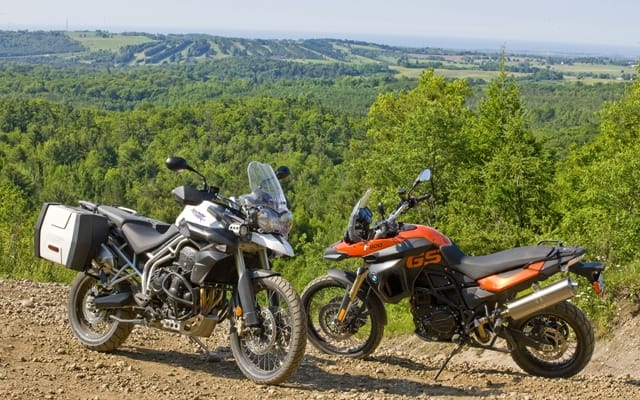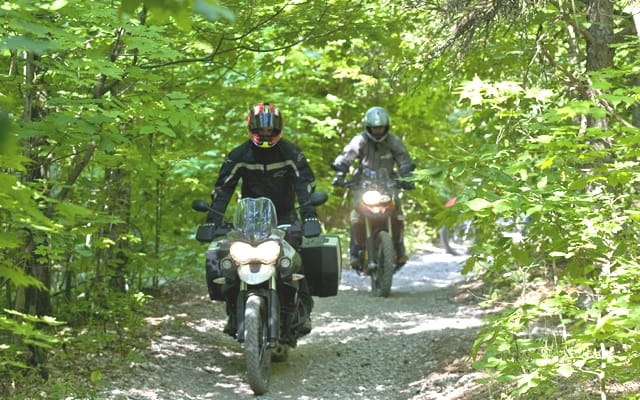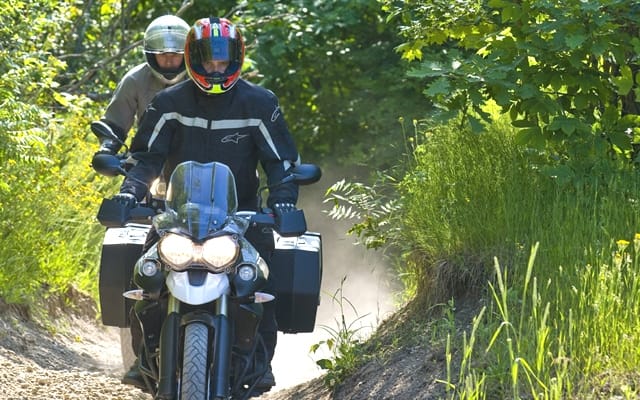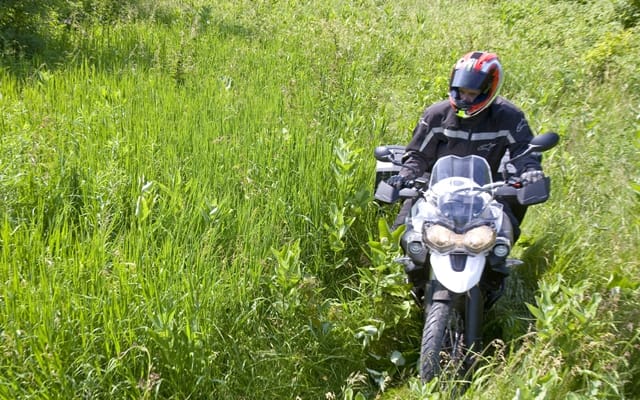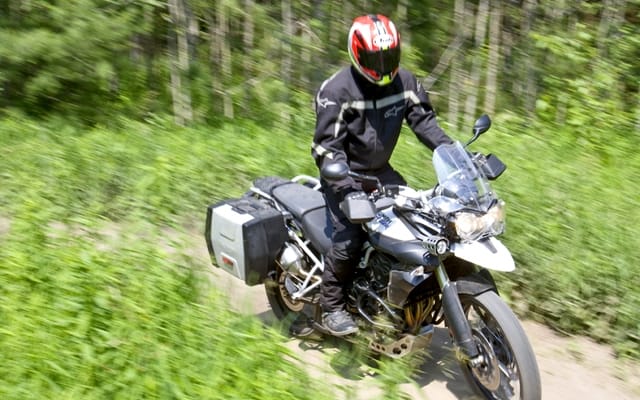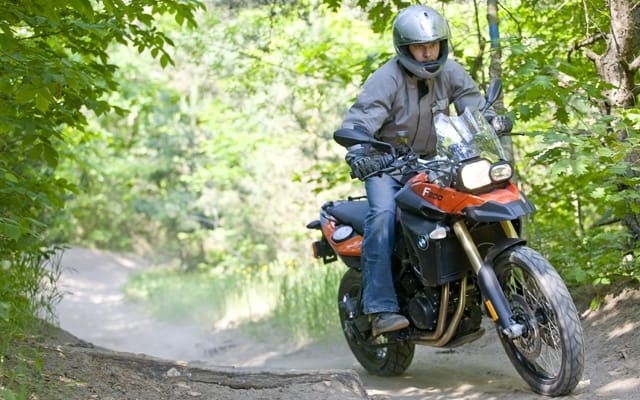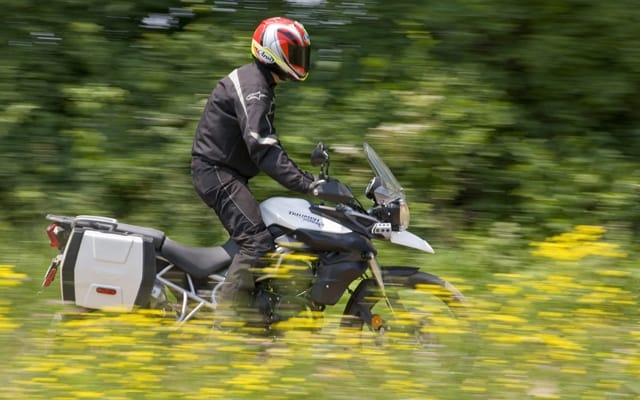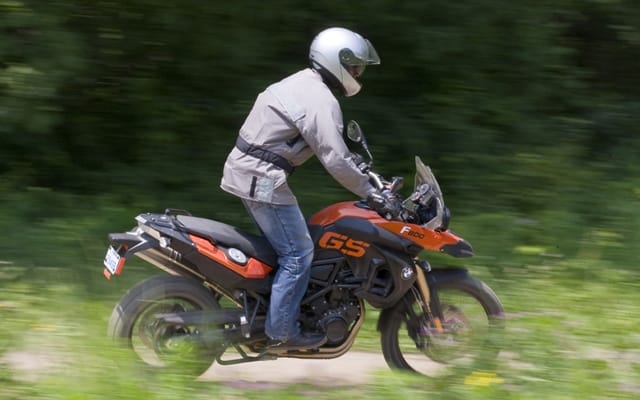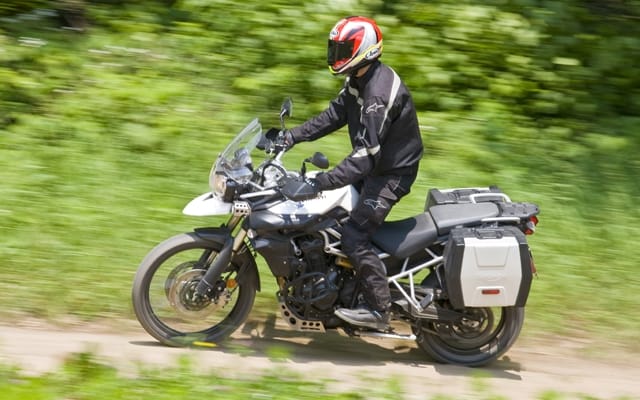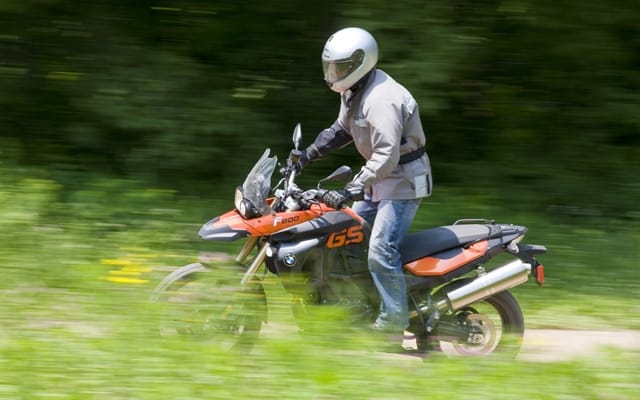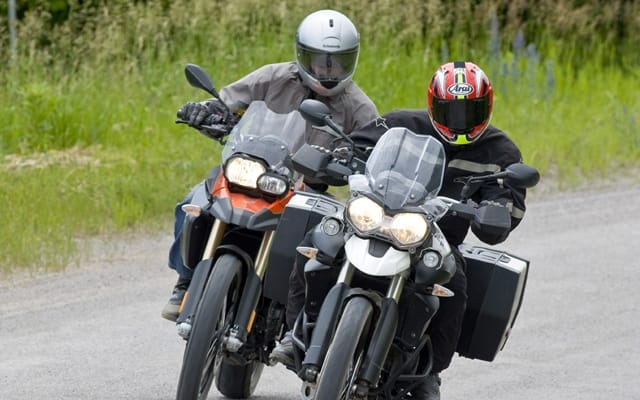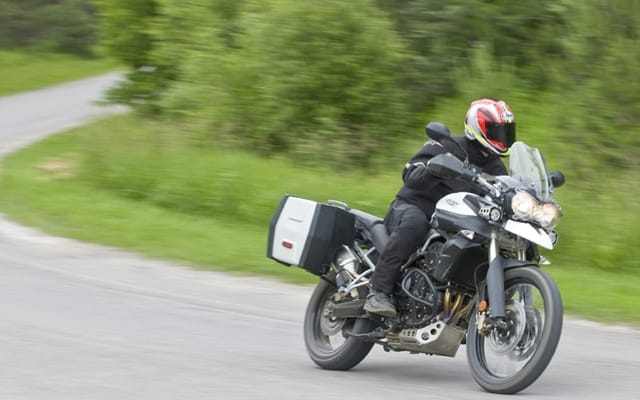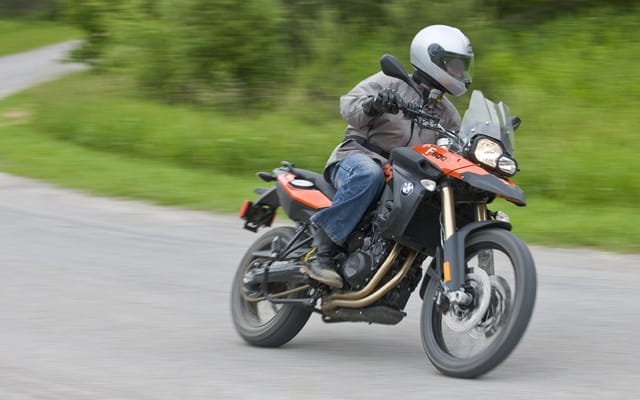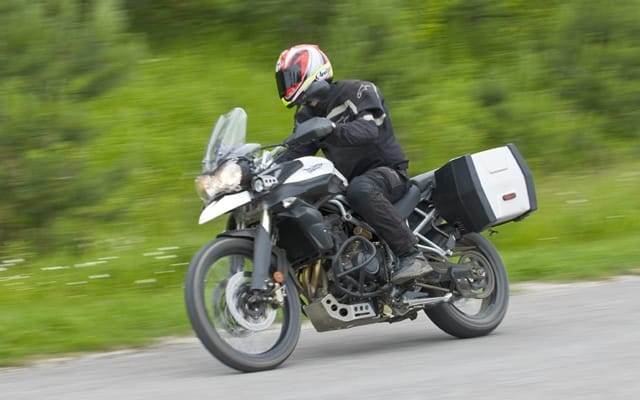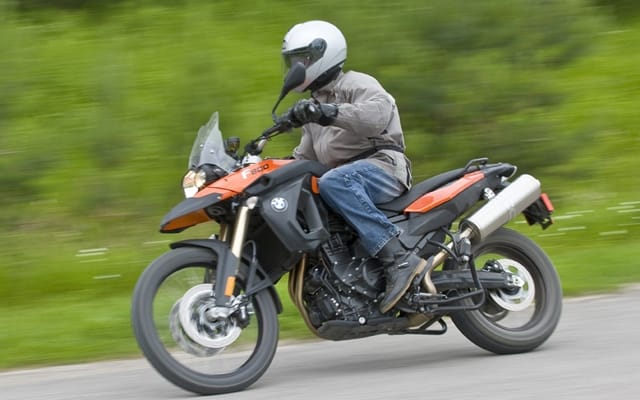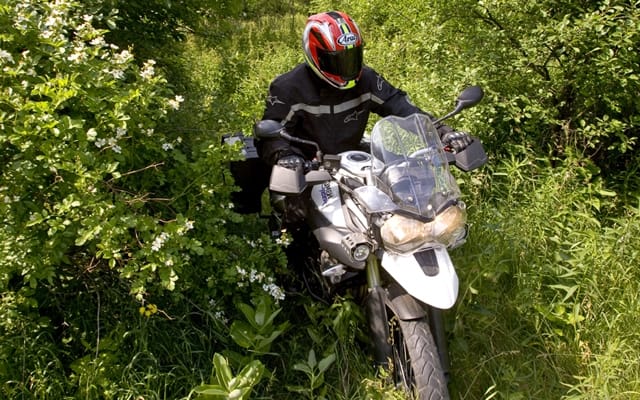They seem similar, but in the same way that a few inches makes a difference around the waistline, this pair goes about their business in entirely different ways.
Sand feels great between the toes. It does not feel great under a large motorcycle fitted with tires better suited to pavement.
Derreck Roemer, on a BMW F800GS, is attempting to film Neil Graham riding the Triumph Tiger 800XC down a slippery lane in the Ganaraska Forest east of Toronto. The problem is that the Tiger looks like it’s being steered by a drunken sailor with his hand on the tiller. From one side of the trail to the other the bike squirms on its Bridgestone Battlewings and appears on the verge of perpetual collapse. When, at a rest stop, an unknown rider on a new KTM enduro with knobbies stops to complain about too much sand on the trails, Neil nearly throws sand in his face.
Steve Weykamp, from Trail Tours Dirtbike School has agreed to be our guide though the forest, but he’s concerned for Derreck and Neil. He doesn’t think they can man-handle those bikes through the sand. Not with those tires. Big bikes (by off-road standards) like the Triumph and BMW, fitted with knobbies, and with an experienced pilot at the controls, can go virtually anywhere. But you can’t stop and change tires every time you want to squirt into the woods. What we wanted to find out was if one could make haste through the forest with OEM tires. The answer is yes, sort of, but first a primer on riding in sand.
A motorcycle does not want to fall down. But a motorcycle on a slippery surface is intolerant of an indecisive rider, just as a horse bucks off the equestrian who baffles it with muddled inputs. What you do is keep your eyes up, stand up to keep the weight down on the pegs, and keep your torso tight but the arms loose. The last one is the hardest: our natural tendency is to hold onto with a death grip what we believe is about to be ripped from our hands, no matter if it’s a wallet or a handlebar. But remember that the gyroscopic effect is your friend, and that two-wheelers are self-adjusting: a little throttle and a soft grip at the handlebar straightens out whatever problems you’ll encounter. Well, most of them anyway — at least if you crash you’ll be loose, which means that you’re less likely to break bones.
We found out what no spec sheet can tell: the BMW is way better in the dirt than the Triumph. It’s thinner in the mid-section and the fact that it’s eight kilograms lighter than the Triumph makes a surprisingly significant difference in feel. The Triumph always feels a little top heavy, a little ponderous. The Triumph also has a ferociously strong engine, too strong, in fact, for delicate work in the dirt unless a judicious throttle hand is employed. Give it a twist and rocks and sand spray from the rear tire like the roost from a hydroplane. The BMW’s parallel twin, by comparison, is almost boxer-like in its ability to chug along uncomplainingly at very low revs. It also has an extremely linear power delivery that allows for the smooth application of predictable power. It’s for reasons like this that flat trackers have used singles and twins for propulsion since time immemorial.
When the sand subsided (sadly, only briefly) both bikes handled rutted and rocky trails with relative ease. The Triumph’s suspension is unusually plush, and it could hammer over fist-sized rocks embedded in the dirt of a hard trail and return a ride plusher than you’d get from a sportbike on most paved roads in this country. Both testers came with ABS, which is an option whose selection should never be an option. But ABS is not a good idea off-road. When traction is limited, sometimes a rear wheel has to skid to pile up rocks under the tire to create a ramp with which to wedge itself to a halt. A steep decline with active ABS can terrify, as the tire, unable to find traction, keeps rotating and the bike, moving.
A hint of the manufacturers’ intended use for these machines is revealed in the methods by which the ABS is turned off. On the BMW, there is a large button marked ABS on the left switch block. Hold it down while you’re stopped, and the ABS light on the dash stays on permanently, indicating that the ABS is off. This action can be performed while the ignition is on and the bike stationary. The Triumph, on the other hand, requires that the ignition be on, the bike in neutral, and the rider have the patience of Job. Small buttons on the dash require either awkward poking with a gloved finger or, better yet, gloves to be removed entirely. Then it’s necessary to poke a pair of buttons to find the right menu to disable the ABS. It’s as if the mother ship Triumph is trying to discourage us from abandoning tarmac.
After six hours in the dirt (and after Derreck confessed that his underwear was “soaked wet” by all of the exertion) Neil, as supreme leader and the man with the corporate credit card, determined that the off-road experiment was over. The final word on the dirt-going ability of these two motorcycles? Both can do it, though the BMW can do it better, and both require proper off-road tires for anything deadly serious. It’s better to think of them as bad-road bikes, not off-road bikes, and with that in mind, we set off in search of paved roads with pockmarked surfaces of the type that abound in Ontario.
After 20 kilometres on pavement it became apparent why the Triumph was mediocre in the dirt: it’s simply spectacular on the road. The suspension is sublime. It soaks up imperfections in pavement better than a vacuum cleaner, and though the suspension isn’t taught, road feel is good. We’re fond of Triumph’s three-cylinder engines, and the mill in the Tiger might just be the best of them all. Comparable in feel to the 675 cc Street Triple engine, the Tiger mill benefits from a boost in displacement and an emphasis on bottom-end and mid-range performance. Throttle response that was too peaky off-road became deliciously addictive on-road. You don’t have to go in search of revs to make the engine sing, either, as power builds nicely from 3,000 rpm. Canadian Triumph guy Chris Ellis cheated and loaded down the Tiger with accessories, including an Arrow exhaust canister ($959.99) that let just enough of the triple’s growl out to satisfy, but not enough to aggravate. We wish all pipes were as thoughtfully considered as this one.
Having not ridden the F800GS in some time, we were as initially impressed with its off-road capability as we were concerned with the engine’s buzzyness. No matter how much technology is employed in any motorcycle design, you can never entirely suppress an engine’s inherent characteristics. And with a vertical-twin, that means the vertical-twin buzz. But we quickly learned that it wouldn’t be a problem, as we’d only been seduced by the exceptionally smooth mill of the Triumph. No matter how long we rode the BMW, or how fast we rode it, its vibes never became tiresome.
What did become tiresome with the BMW (aside from its traditional BMW turn signals that the brand stalwarts adore but that aggravate the rest of us) was the flighty feeling from the front end. Leaving the city for an early morning photo shoot, our crew of testers was surprised by how the dirty air on the highway battered the BMW about. It’s true that a wide handlebar tends to exacerbate rider input, often leading to rider-generated instability, but even with the lightest of hands on the handlebar, the BMW’s front end did little to reassure, oscillating as it did in the wind. With a hunch that the overly soft rear shock (allied to a more firmly sprung fork) might be causing the machine to pivot on the front axle, we added, via the hand-operated knob on the right side of the machine, as much spring preload as we could, and though it added stability at speed, it never entirely solved the problem. And this is for a machine that was without panniers or a passenger, additions that would only have exacerbated the problem.
The Triumph’s broader seat made it a more comfortable perch, though the narrow front of the BMW seat would make it better for shorter riders. As we’re familiar with BMW’s panniers, we weren’t too disappointed that the GS came without bags, but the Triumph’s bags ($959.99), though looking combat ready, had quirks of their own. We’ve written in the past that pannier design is one area where there is very little consistency from manufacturer to manufacturer. It can seem, at times, that they’re all struggling to figure out how to do it. Triumph, oddly, lets the bottom of their bags “float” back and forth a few inches while the top of the bag is securely gripped. The problem is that the bottom of the bag pops out of the mount, even after we’d confirmed that the top was secure. But they never fell off, which is more than we can say for the bags of some motorcycles tested by the magazine over the years.
On the back roads to the town of Calabogie, west of Ottawa, the BMW was the livelier of the two, but where it was nimbler than the Triumph, it was also matched in speed by the Triumph. Heading south to Perth on the sublime 511, the Triumph, panniers loaded down with a computer and Mr. Roemer’s evening wear, used its superior power to distance itself from the BMW while giving the rider a more comfortable perch. Though they share, broadly, the same design brief, we were surprised by the Triumph’s suitability as a good old-fashioned touring machine. We’d like to experiment with the higher windshield in the accessory catalogue (both machines have similar wind-cheating capability — good, though not great) to see if some of the buffeting could be reduced.
When we began the test we thought we’d be splitting hairs to pick a victor, but the GS and the Tiger are so different that it’s like choosing between a sporting sedan and a half-ton. The BMW is a bike worthy of its GS lineage, while the Tiger is ideal for the crumbling infrastructure of an economy still on the mend. Which is best for you is a matter entirely of how you ride.
FROM THE SADDLE
If Neil had told me ahead of time that he wanted me to ride the 215 kg pannier-laden Tiger 800XC up a sand and pebble-covered goat path to the summit of one of the highest hills in the Ganaraska Forest, I most likely would have declined taking part in this test. Unlike our editor, who’s ridden with Dakar Rally champion Cyril Despres through the notoriously treacherous terrain of the Erzberg Rodeo, my off-road riding experience had heretofore been nil. I’d never ridden a true dirt bike anywhere (and still haven’t). The closest I’d come to off-roading was navigating hard-packed sand or gravel secondary roads aboard adventure tourers. The fact that both our testers were shod with dual-sport tires, rather than knobbies, made the idea of my inaugural off-road hill climb doubly daunting.
It’s a testament then to the Tiger 800XC’s off-road bona fides that an inexperienced rider not only made it up and down that hill without incident, but that my initial trepidation also turned to pure enjoyment. That said, the Tiger did show glaring limitations in the deep and loose sandy sections of the Ganaraska trails, where it would disconcertingly fishtail out of control. And though the BMW also had trouble plying the sand, the GS’s parallel twin felt like the better motor of the two for off-roading, providing me with exhilarating bursts of low-end torque on uphill climbs and superior engine braking going back down. That the GS is lighter than its Hinckley competition by eight kilograms (and also pannier-less) was immediately noticeable in the dirt; though it’s the taller machine of the two, I found the Beemer less top-heavy and significantly nimbler than the Triumph, inspiring greater confidence on the trails.
But on pavement I preferred the Triumph. Its three-cylinder engine is silky smooth compared to the BMW’s slightly buzzy parallel twin, and the Tiger’s nine horsepower advantage makes passing on the highway effortless. Both machines acquitted themselves well during spirited riding through the twisties, but even though the Tiger feels the plusher ride of the two (its seat is certainly the most comfortable), it was BMW’s front end that lacked feeling and caused me to loose confidence during some of the tighter turns between Calabogie and Perth. For its superior power, comfort, and back-road handling I’ll take the Triumph. Off-road it may be the slightly lesser of the two, but let’s face it; the only time I’ll ever be riding without proper tires on dirt bike trails again is if this magazine pays me to do it.
– Derreck Roemer
After the excruciatingly long teaser ad campaign (a wheel here, a bit of frame there) that Triumph forced us to endure prior to the Tiger 800XC’s “official” release, it was a relief to finally ride the machine. And a further relief to find that it’s a good bike. That engine’s got a lot to do with it. Triumph’s three bangers, like Ducati’s twins, seem to suit everything from hardcore sportbikes to go-anywhere tourers. It’d probably work well in a log splitter. But the XC is no log splitter, unless it gets away from you in the sand and fires itself at a tree.
The BMW, sitting as it does on the more dirt-friendly side of the divide, is a little less appealing for straight road use, but as a machine to ride to the forest for trail riding before riding back home again, it’d be nearly ideal. I still don’t know why that front end was so touchy: the bike was nearly new and certainly the shock couldn’t have passed its due date so early in its life.
Where the Triumph’s teaser campaign seemed to go astray was in its depictions of manly men doing radical off-roading, because, at heart, this is a plush street bike not radically different from the V-Stroms of the world. And though that may sound like criticism, it’s not, at least not in my book. I enjoy the occasional blast through the woods, but in truth I’m a road rider.
What I like about the Tiger is that it would allow me to travel down the kind of dirt roads that force me to turn around when I’m on street-biased machinery. If that’s your interpretation of “off-roading,” then this bike is a good as it gets.
– Neil Graham
SPECIFICATIONS
MODEL Triumph Tiger 800XC BMW F800GS
PRICE $12,199 ($16,254.93 as tested) $12,750 ($13,820 as tested)
ENGINE Liquid-cooled 12-valve in-line triple Liquid-cooled eight-valve parallel twin
HORSEPOWER (CLAIMED) 94 @ 9,300 rpm 85 at 7,500 rpm
TORQUE (CLAIMED) 58 lb-ft at 7,850 rpm 61 lb-ft at 6,750 rpm
DISPLACEMENT 799 cc 798 cc
BORE AND STROKE 74 x 61.9 mm 82 x 75.6 mm
COMPRESSION RATIO N.A. 12.0:1
FUEL DELIVERY EFI EFI
TRANSMISSION Six-speed Six-speed
SUSPENSION Telescopic 45 mm fork with 220 mm travel; single rear shock with 215 mm travel;
Telescopic 45 mm fork with with 230 mm travel; single rear shock with 215 mm travel
WHEELBASE 1,545 mm (60.8 in.) 1,578 mm (62.1 in.)
RAKE/TRAIL 24.3 degrees/95.3 mm N.A./117 mm
BRAKES Twin front 308 mm discs with twin-piston calipers; rear 255 mm disc with single-piston caliper
Twin 300 mm front disc with twin-piston calipers; 265 mm rear disc with with single-piston caliper
TIRES 90/90-21 front; 150/70-17 rear 90/90-21 front; 150/70-17 rear
WEIGHT (CLAIMED) 215 kg (473 lb) wet 207 kg (456 lb)
SEAT HEIGHT 845 – 865 mm (33.2 – 34 in.) 880 mm (34.6 in.)
FUEL CAPACITY 19 L 16 L
FUEL CONSUMPTION 5.9 L/100 km (48 mpg) 6.5 L/100 km (43 mpg)
FUEL RANGE 320 km 243 km
